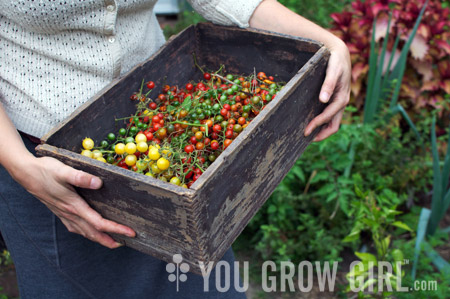
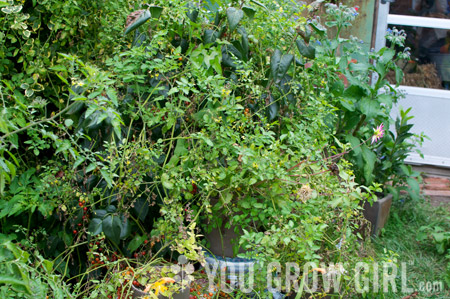
It is a chaotic blanket of thin, tangled branches smothering the lilac bush. A wild thing in a garden that has gone mad with wild things and wildness. And once it got going that poor potted dahlia hardly stood a chance.
I’ve realized that it is a living approximation of my grandmother’s “Christmas tree.” My garden’s tribute of sorts to the mass of potted tropical vines and houseplants that she decorated with small glass balls and assembled into a triangular “tree” shape each December.
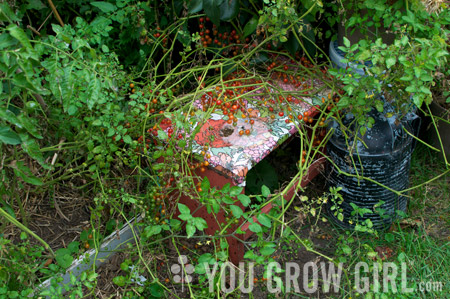
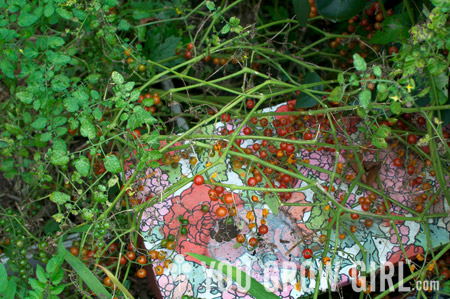
I tell myself that it is for this sentiment that I leave the plant intact and let it run free. There is also the fruit to consider. Shiny, little bobbles of colour that fall in strings. Many fall to the ground. The dog chews the moist guts out of them. I’ll be on my knees plucking their progeny in droves next spring as penance for my reckless indifference now.
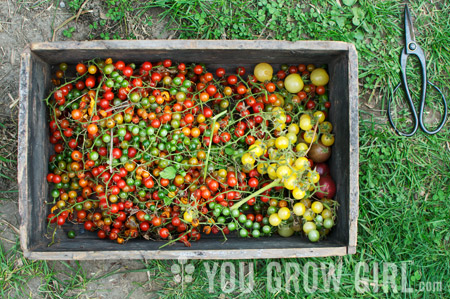
Did you know that wild, red currant tomatoes like this one are of a difference species than most of the other tomatoes that we grow in our gardens? Lycospericon pimpinfolium (ummmm… tiny pimpin’ yo ???) is native to the West coasts of Peru and Ecuador (see “Vegetables” by Roger Phillips and Martyn Rix.) These pea-sized tomatoes are tough-skinned, but sweet and juicy. The plant is a delicate, yet aggressive menace that is impossible to keep in order (even when effort is applied), but I can not resist its charm.
We separated the ripe from the green last night and I am planning to pickle them both separately later. My recipe for pickled green tomatoes is in my book, “Drinking the Summer Garden.” I have yet to work out a recipe for the ripe. I have pickled ripe in the past, but the recipe I made was meant for the ‘White Currant’ fruit that you can also see in the bottom photo and doesn’t seem fitting for these.
We had the same issue coming back from our recent trip. Overgrown tomato plants, falling over with weight, spitting out dozens of tomatoes.
You always want it right up to the point you have it.
Great post.
My San Marzano and Brandywine tomato plants were allowed to go wild this year. I planted one of each a week before my second daughter was due in early June. I knew that I wouldn’t have time to care for them properly, but I couldn’t stand the thought of a summer without them. I even managed to put up some stakes and tie a few braches down, but they soon broke free and have sprawled over the sides of their raised bed, threatening the lives of the potted plants all around. I’ve actually enjoyed it though, unearthing tomatoes and fighting my way through vines to get to the basil and parsley plants still growing in the middle of the bed.
“Tiny pimpin yo”. LOL! Love this blog, especially since I’ve gone from being terrified to grasshoppers to running a farmer’s market to instituting a gardening initiative in the the ‘hood.
It couldn’t be helped.
p.s. Great trajectory!
Happy October! :-)
I’ve never grown currant tomatoes, but they look really neat. Are they at all blight resistant? I find that if I don’t keep my tomatoes mulched, staked and pruned, I have a terrible time with blight. I wonder if the currant tomatoes would fare any better than “regular” tomatoes?
I slow roast excess ripe cherry tomatoes at 200 or 250 F for several hours (watch carefully after about an hour and a half… they can go from roasted to dried/caramelized/burnt surprisingly quickly, even at 200) and then freeze them for the winter. They’re good on toast, with pasta, or in a salad. I cut the cherry tomatoes in half first, drizzle with olive oil and sprinkle with basil salt before baking. Perhaps this would also work with the currant tomatoes? (I doubt you’d need to cut them in half.)
I’ve never had a problem with them producing. They used to self-seed in my community garden.
I’ve never tried drying these as they are so teeny. I slow dry everything else.
I’ve been growing current tomatoes for 2 years now (seeds from Botanical Interests, Latin name Lycopersicon pimpinellifolium). There were 2 varieties in the packet, red and yellow. So I had red one last year, didn’t cage, it went crazy, it was 4×10 foot tomato plant. This year I’m growing yellow one since I didn’t mark them and gave all the red ones away, I caged it, but it’s still a mess, more like 4×6 plant though. They are very similar in taste, maybe the yellow one is tiny bit sweeter, though skins, both produce huge quantities of fruit, and I end up with pints of teeny green tomatoes at the end of the season. Leaves look more like potato than tomato.
These “gone wild” tomatoes make a terrific jam/preserve or whatever you call it. I had 2 wild ones 3 years ago and picked the ripe ones daily until I had enough to make a batch in the microwave. Made about 12 jars altogether. All finished now but have 2 more wild plants this spring.
I’ve grown both yellow and red currant tomatoes for several years. They live in containers on my porch, as I planted them in the ground the first year and never wish to repeat that experience. I do prune them rather ruthlessly, which keeps them to a reasonable size. LOTS of fruit on these tiny pimpin’ yo.
I like putting them in cheddar-corn muffins, salads, and a lovely baked tomato-shrimp-feta dish.